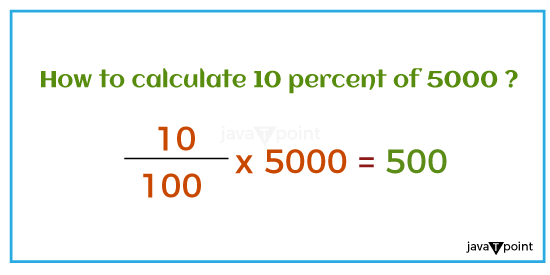What is 10% of 5000?Percentage is an important concept in Mathematics and everyday life. It is used to express proportions and make comparisons. In this article, we will learn about percentages and explore the 10% of 5000 calculation. After understanding this basic concept, we will understand how the percentage work and apply this knowledge to various real-life applications. Understanding PercentageBefore we learn the 10% of 5000 calculation, let's understand clearly "What is the percentage?" A percentage represents a fraction of the whole multiplied by a hundred (100); it helps us express parts of a whole in a standard way. Percentages are denoted by the symbol "%." What is the Actual Meaning of 10% of 5000?In particular, 10% of 5000 is 500. We can understand this concept by simply assuming 5000 as 100 equal parts and objects and can assume anything; then 10 parts or objects from those 100 equal parts are considered 10%; for our case, 500 is the answer. 
Steps to Calculate 10% of 5000We will learn how to calculate 10% of 5000 with the help of simple steps explained in the following lines. Step 1. First, write the product of both numbers, i.e., 10% and 5000, as shown below. 10% * 5000 Step 2. As we know, the meaning of percentage is the 100th part of a number or anything, so that we can replace the "%" with (1 / 100). 10% * 5000 = (10 / 100) *5000 Step 3. Using the rules of multiplication and simplification, we get the following: 10% * 5000 = (10 / 100) *5000 50000 / 100 500 Real-World ApplicationsUnderstanding percentages and their calculations can be very helpful in various real-life situations. Let us discuss some examples:
Some Solved ExamplesQ. What is 5% of 1500? Solution: Step 1. 5% * 15 Step 2. 5% * 15 = (5 / 100) * 1500 Step 3. 5% * 15 = (5 / 100) * 1500 = 7500 / 100 = 75 Q. What is 21% of 5100? Solution: Step 1. 21% * 5100 Step 2. 21% * 5100 = (21 / 100) * 5100 Step 3. 21% * 5100 = (21 / 100) * 5100 = 1,07,100 / 100 = 1071 Q. What is 17% of 2000? Solution: Step 1. 17% * 2000 Step 2. 17% * 2000 = (17 / 100) * 2000 Step 3. 17% * 2000 = (17 / 100) * 2000 = 34,000 / 100 = 340 Q. What is 88% of 91? Solution: Step 1. 88% * 91 Step 2. 88% * 91 = (88 / 100) * 91 Step 3. 88% * 91 = (88 / 100) * 91 = 8008 / 100 = 80.08 Q. What is 39% of 5000? Solution: Step 1. 39% * 5000 Step 2. 39% * 5000 = (39 / 100) * 5000 Step 3. 39% * 5000 = (39 / 100) * 5000 = 1,95,000 / 100 = 1,950 Q. What is 20% of 5000? Solution: Step 1. 20% * 5000 Step 2. 20% * 5000 = (20 / 100) * 5000 Step 3. 20% * 5000 = (20 / 100) * 5000 = 1,00,000 / 100 = 1,000 ConclusionPercentages are a fundamental concept of Mathematics that allows us to express proportions and make comparisons. In our case of calculating 10% of 5000, we multiply the total value by 10% (0.10) to obtain the result. This knowledge is useful in mathematics and applicable in various real-world scenarios, such as sales, gratuity, and financial investments. Understanding percentages and proportions can enhance our problem-solving abilities and help us make informed decisions in various aspects of life.
Next TopicWhat is 10% of 5000
|
 For Videos Join Our Youtube Channel: Join Now
For Videos Join Our Youtube Channel: Join Now
Feedback
- Send your Feedback to [email protected]
Help Others, Please Share










